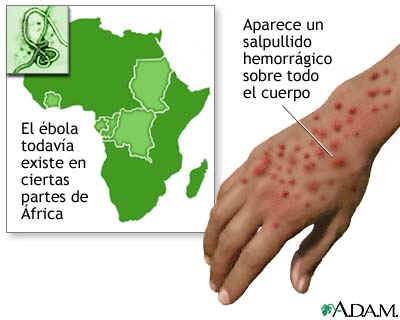
PROFILES OF FILOVIRUSES: EBOLA AND MARBURG
EBOLA
Strains: There are four known strains of Ebola viruses: Ebola Zaire, Ebola Sudan, Ebola Reston, and Ebola Cote d’Ivoire. These strains have been named for the regions in which they first occurred, and show differing virulence, with Ebola Zaire causing the greatest mortality (approximately 90%)
Incubation: 2-21 days
Epidemiology: First recognized in 1976, Ebola has primarily affected humans and apes in Africa, including Zaire (September, 1976), Sudan (July, 1976), Cote d’Ivoire (1995), Uganda (December 2000), Kikwit (May 1995), and more recently Gabon and The Democratic Republic of Congo (December 2001-2002, January 2003-April 2003, and October 2003-December 2003). It has also been noted in a U.S. laboratory in Reston, VA (October 1989).Symptomatology and Outcome: Often fatal, this disease often begins with fever, headache, myalgia, and sore throat. It then gives way to diarrhea and vomiting, and typically results in blistering and internal hemorrhaging.

Ebola blistering, NIAH,http://www.nlm.nih.gov/medlineplus/spanish/ency/esp_imagepages/17160.htm
Prevention and management: While the reservoir for this disease is unknown, human Ebola outbreaks seem to occur after animal meat infected with the virus has been consumed or the carcass handled. This most often affects hunters, therefore preventive education has targeted this group. Furthermore, the outbreaks are often located in remote towns that border African wilderness, in which traditional healing is practiced in response to disease rather than Western medical techniques, and burial preparation for the deceased may involve coming into contact with infected bodily fluids. While education campaigns have sought to instruct the affected populations on the necessity of quarantining infected individuals, medical relief workers have sometimes attempted to accommodate the burial rituals by volunteering to perform them in full protective gear. Because Ebola has such a high mortality rate, management efforts primarily focus on quarantining infected individuals and offering them palliative care, with special attention given to restoring hydration and electrolyte balance.
References: CDC, "Ebola Hemorrhagic Fever," http://www.cdc.gov/ncidod/dvrd/spb/mnpages/dispages/ebola.htm; CDC MMWR, "Outbreak of Ebola Hemorrhagic Fever – Uganda, August 2000-January 2001," http://www.cdc.gov/mmwr/preview/mmwrhtml/mm5005a1.htm
MARBURG
Incubation: 5-10 days
Epidemiology: Outbreak in laboratories in Marburg and Frankfurt, Germany and Belgrade, Yugoslavia (all in August 1967). 37 people were infected, all of whom were laboratory workers, medical professionals, or family members who cared for infected individuals. The initial infections were found in people working with green monkeys or their tissues. Outbreaks have since occurred in Johannesburg, South Africa (1975), Western Kenya (1980 and 1987), and The Democratic Republic of Congo (1998). Marburg affects humans and other primates.
Symptomatology and Outcome: Initial symptoms include fever, headache, myalgia, and chills. Approximately five days after symptoms first appear, patients are often nauseated, vomiting, have diarrhea, a sore throat, and a maculopapular rash. This may then progress to weight loss, shock, pancreatitis, liver failure, and hemorrhaging. Marburg Hemorrhagic Fever has a 25%-33% mortality rate.
Prevention and management: As with Ebola, preventive measures primarily focus on interrupting human-human spread of the virus by quarantining individuals with suspected infection. Again, because there is no cure, treatment is largely palliative.
Reference: CDC, "Marburg Hemorrhagic Fever," http://www.cdc.gov/ncidod/dvrd/spb/mnpages/dispages/marburg.htm